|
JAISALMER
Nothing else in India is remotely similar to
Jaisalmer. Jodhpur certainly has one of the country’s most spectacular
fortress palaces complexes, and both Chittorgarh and Kumbhalgarh far
surpass Jaisalmer in fame and sheer size.
Centuries
ago, Jaisalmer’s strategic position on the camel train routes between
India and central Asia brought it great wealth. The merchants and
townspeople built magnificent houses and mansions, all exquisitely carved
wood and from golden-yellow where in Rajasthan but nowhere are they quite
as exotic as in Jaisalmer. Even the humblest shops and houses display
something of the Rajput love of the decorative arts in its most whimsical
form. It’s likely to remain that way for a long time to come, too, since
the city planners are keen to ensure that all new buildings blend in with
the old.
Orientation
The old city was once completely surrounded by an
extensive wall, much of which has sadly been torn down for building
material in recent years. Much remains, however, including the city gates
and, inside them, the massive fort which rises above the city and is the
essence of Jaisalmer. The fort itself is a warren of narrow, paved streets
complete with Jain temples and the old palace of the former ruler, still
flying his standard.
The
central market area is directly below the hill, while the banks, the new
palace and several other shops and offices are near the Amar Sagar Gate to
the west.
Fort
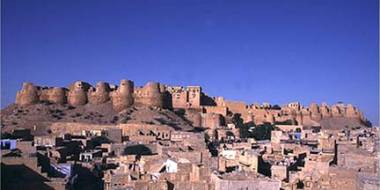 Built in 1156 by Rawal Jaisal, the fort crowns the
80-metres-high Trikuta Hill. About a quarter of the old city’s
population resides within the fort walls, which have 99 bastions around
their circumference. It’s fascinating to wander around this place.
Nothing has changed here for centuries and if ever an effort were made to
pack as many houses, temples and palaces into the smallest possible area,
this would be the result. It’s honey-combed with narrow, winding lanes,
all of them paved in stone and with a remarkably efficient drainage system
which keeps them free of excrement and effluent. It’s also quiet
–vehicles are not allowed up here and even building materials have to be
carried up by camel cart. The fort walls provide superb views over the old
city and surrounding desert. Built in 1156 by Rawal Jaisal, the fort crowns the
80-metres-high Trikuta Hill. About a quarter of the old city’s
population resides within the fort walls, which have 99 bastions around
their circumference. It’s fascinating to wander around this place.
Nothing has changed here for centuries and if ever an effort were made to
pack as many houses, temples and palaces into the smallest possible area,
this would be the result. It’s honey-combed with narrow, winding lanes,
all of them paved in stone and with a remarkably efficient drainage system
which keeps them free of excrement and effluent. It’s also quiet
–vehicles are not allowed up here and even building materials have to be
carried up by camel cart. The fort walls provide superb views over the old
city and surrounding desert.
The fort is entered through a forbidding series of massive gates
leading to a large courtyard. The former maharaja’s seven –storey
palace fronts onto this. The square was formerly used to review troops,
hear petitions and present extravagant entertainment for important
visitors. Part of the palace is open to the public, but there’s little
to see inside, although one room has some beautiful murals. Opening hours
are 8 am to 1 pm and 3 to 5 pm.
Jain Temples
Within the fort walls are a group of beautifully
carved Jain temples built between the 12th and 15th
centuries. They are dedicated to Rikhabdevji and Sambhavanthji.
The
Gyan Bhandar, a library containing some extremely old manuscripts, is also
in the temple complex. The temples are only open in the morning until noon
and the library only opens between 10 and 11 am. There are also Siva and
Ganesh temples within the fort.
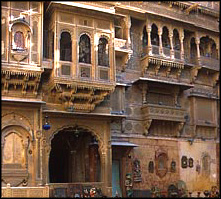 Havelis Havelis
The beautiful mansions built by the wealthy merchants
of Jaisalmer are known as havelis, and several of these fine sandstone
buildings are still in beautiful condition.
Patwon Ki Haveli
This most elaborate and magnificent of all the
Jaisalmer havelis stands in a narrow lane. It’s
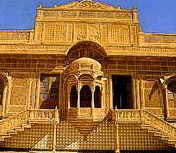 divided
into five apartments, two owned by the Archaeological Survey of India, two
by families who operate craft shop here, and one still lived in that is
closed to the public. There are murals on some of the inside walls and a
fine view from the roof. divided
into five apartments, two owned by the Archaeological Survey of India, two
by families who operate craft shop here, and one still lived in that is
closed to the public. There are murals on some of the inside walls and a
fine view from the roof.
Salim Singh ki Haveli
This haveli was built about 300 years ago and part of
it is still occupied. Salim Singh was the prime minister when Jaisalmer
was the capital of a princely state, and his mansion has a
 beautifully
arched roof with superb carved brackets in the form of peacocks. The
mansion is just below the hill and, it is said, once had two additional
wooden storeys in an attempt to make it as high as the maharaja palace.
The maharaja had the upper storeys of the prime minister’s haveli torn
down! beautifully
arched roof with superb carved brackets in the form of peacocks. The
mansion is just below the hill and, it is said, once had two additional
wooden storeys in an attempt to make it as high as the maharaja palace.
The maharaja had the upper storeys of the prime minister’s haveli torn
down!
Nathmal ki Haveli
This later 19th –century haveli was
also a prime minister’s house. The left and right wings of he building
 were
carved by brothers and are very similar, but not identical. Yellow
sandstone elephants guard of building, and even the front door is a work
of art. were
carved by brothers and are very similar, but not identical. Yellow
sandstone elephants guard of building, and even the front door is a work
of art.
Gadi Sagar Tank & Museum
This tank, south of the city walls, was once the
water supply of the city and there are many small temples and shrines
around it. A wide variety of water birds flock here in winter.
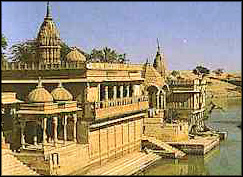 The
beautiful gateway which arches across the road down to the tank is said to
have been built by a famous prostitute. When she offered to pay to have
this gateway constructed, the maharaja refused permission on the grounds
that he would have to pass under it on going down to the tank, and he felt
that this would be unseemly. While he was away, she built the gate anyway,
adding a Krishna temple on top so the king could not tear it down. The
beautiful gateway which arches across the road down to the tank is said to
have been built by a famous prostitute. When she offered to pay to have
this gateway constructed, the maharaja refused permission on the grounds
that he would have to pass under it on going down to the tank, and he felt
that this would be unseemly. While he was away, she built the gate anyway,
adding a Krishna temple on top so the king could not tear it down.
The small museum here has displays of folk art. Open daily from 10
am to 5:30 pm.
Festivals
The annual Desert Festival is supposed to have camel
races and dances, folk music, desert ballads and puppeteers, but it seems
to have quickly become a purely commercial tourist trap. The RTDC sets up
a special ‘Tourist Village’ at this time, similar to the one in
Pushkar. The festival takes place between late January and mid-February.
Things to Buy
Jaisalmer is famous for embroidery, Rajasthani mirror work, rugs, blankets, old stonework and antiques. Tie-dye and other
fabrics are made at the Kadi Bundar, north of the city. One traveller
reports that you should watch out for silver items bought in Jaisalmer as
the metal may be adulterated with bronze.
Getting There & Away
Air: Jagson Airlines has an office at the
Tourist Bungalow and flies between Jaisalmer and Delhi via Jodhpur on
Tuesday, Thursday and Saturday.
Bus: The main bus terminal is some distance
from the center of town, near the railway station. Fortunately, all buses
start from the traffic roundabout just outside Amar Sagar Gate, and then
call at the main station. Reservations are only needed on the night buses,
and these should be made at the main bus terminal.
There are eight daily STC buses on the route to Jodhpur, the deluxe
one leaving at 5 pm. For Bikaner (eight hours) there are departures at 6
(deluxe) and 11am, and 8 and 9:30 pm.
Train: At the railway station there’s an
International Tourist Bureau, similar to the one at Jodhpur. It was
comfortable armchairs, and a toilet and shower for use by rail patrons.
The reservations office at the station is only open from 8 to 11 am, 2 to
4 pm and in the chaotic period just below departure
There’s a day and a night train in either direction between
Jodhpur and Jaisalmer. The 295 –km trip takes around nine hours.
AROUND JAISALMER
There are some fascinating places to see in the area
around Jaisalmer, although it soon fades out into a barren sand –duned
desert which stretches across the lonely border into Pakistan.
Due to
the troubles in Punjab and alleged arms smuggling across the border with
Pakistan, most of Rajasthan west of National Highway No15 is a restricted
area. Special permission is required from the Collector’s office in
Jaisalmer if you want to go there, and this is only issued in exceptional
circumstances. The only places exempted are Amar Sagar, Bada Bagh,
Lodhruva, Kuldhara, Akal, Sam, Ramkunda, Khuri and Mool Sagar.
Bada Bagh & Cenotaphs
Only a km or so north of Jaisalmer, Bada Bagh is a
fertile oasis with a huge old dam. Much of the city’s fruit and
vegetables are grown here and carried into the town each day by
colourfully dressed women.
Above
the gardens are royal cenotaphs with beautifully carved ceilings and
equestrian statues of former rulers. In the early evening, this is a
popular place to watch the setting sun turn Jaisalmer a beautiful golden
brown.
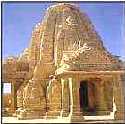 Amar Sagar Amar Sagar
North-west of Jaisalmer, this once pleasant formal
garden has now fallen into ruins. The lake here dries up several months
into the dry season.
A
beautifully carved Jain temple is being painstakingly resorted by
craftspeople brought in from Agra. Commenced in the late ‘70s, this
monumental task is still continuing.
Lodhruva
Further out beyond Amar Sagar, 15 km from Jaisalmer,
are the deserted
ruins of this town which was the ancient capital before
the move to Jaisalmer.
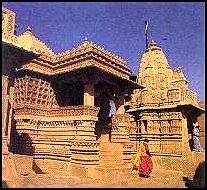 The Jain temples, rebuilt in the late
‘70s, are the only reminders of the city’s former magnificence. The
temples have ornate carved arches at the entrance and a Kalputra,
the Divine Tree, within. In the temple is a hole from which a snake is
said to emerge every evening to drink an offering of milk. The Jain temples, rebuilt in the late
‘70s, are the only reminders of the city’s former magnificence. The
temples have ornate carved arches at the entrance and a Kalputra,
the Divine Tree, within. In the temple is a hole from which a snake is
said to emerge every evening to drink an offering of milk.
At the same time that they rebuilt the temples, Jain benefactors
had the road out from Jaisalmer sealed, but it deteriorates into a desert
track immediately beyond Lodhruva.
Mool Sagar
Situated nine km directly west of Jaisalmer, this is
another pleasant, small garden and tank. It belongs to the maharaja of
Jaisalmer.
Sam
A desert national park has been established in the
Thar Desert near Sam village. One of the most popular excursions is to the
sand-dunes on the edge of the park, 42 km from Jaisalmer. This is the
nearest real Sahara-like desert to Jaisalmer. It’s best to be her at
sunrise or sunset, and many camel safaris spend a night at the dunes. Just
before sunset jeep loads of trippers arrive from Jaisalmer to be chased
across the sands by persistent camel owners offering short rides
There’s
only one bus a day between Jaisalmer, and Sam so if you’re only coming
for the sunset you’ll need to take a tour. It’s well worth camping out
on the dunes but you‘ll need a thick sleeping bag and blankets as it
gets very cold.
Khuri
Khuri is a village 40 km south- west of Jaisalmer,
out in the desert, in the touchy area near the Pakistan border. It’s a
delightfully peaceful place with houses of mud and straw decorated like
the patterns on Persian carpets.
As it’s right on the 40-km limit from Jaisalmer, permits must be
obtained from the Chief Magistrate’s office, opposite the hospital,
before setting out.
There
are infrequent buses between Jaisalmer and Khuri, and the trip takes 2 ½
hours.
Akal Wood Fossil Park
Three km off the road to Barmer, at a point 14 km
form Jaisalmer, are the fossilized remains of a 180-million –year-old
forest. To the untrained eye it’s not particularly interesting.
POKARAN
At the junction of the Jaisalmer, Jodhpur and Bikaner
roads, 110 km from Jaisalmer, is the site of another magnificent Rajasthan
fortress. The sandstone fort rises from the desert and shelters a tangle
of narrow streets line by balconied houses decorated with parrots,
elephants and Rajasthan’s inevitable peacocks.
BARMER
Barmer is a center for woodcarving, carpets,
embroidery, block printing and other handicrafts and its products are
famous throughout Rajasthan. Otherwise, this desert town, 153 km from
Jaisalmer and 220 km from Jodhpur, isn’t very exciting. There’s no
fortress here and the most interesting part is probably the journey to
Barmer through small villages, their mud-walled houses decorated with the
characteristic geometrical designs of each different village. It might be
worth coming for the cattle fair, held at Tilwara nearby over a fortnight
in March / April.
A couple
of buses a day run between Barmer and Jaisalmer (3 ½ hours), and south to
Palanpur in Gujarat. Barmer is also connected to Jodhpur by meter-gauge
railway. Although the line continues on to the Pakistani border, there are
no through trains to that country and, in any case, foreigners are not
allowed to cross the border at this point
|





